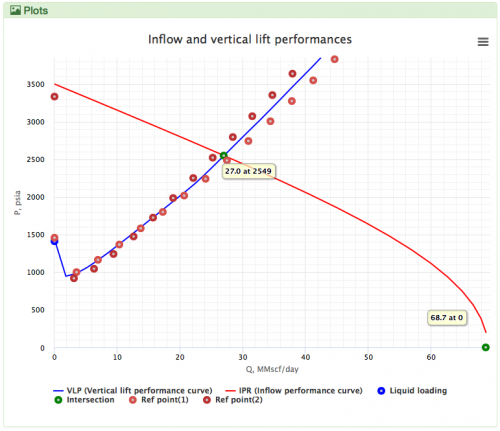Difference between revisions of "Gray correlation"
| Line 6: | Line 6: | ||
[[Gray correlation|Gray]] is the default [[VLP]] correlation for the '''gas wells''' in the [[PQplot]]. | [[Gray correlation|Gray]] is the default [[VLP]] correlation for the '''gas wells''' in the [[PQplot]]. | ||
| − | [[File: | + | [[File: GRAY.png|thumb|500px|Gray in PQplot Vs Prosper & Kappa |right]] |
== Math & Physics == | == Math & Physics == | ||
Revision as of 11:33, 18 May 2017
Contents
Brief
Gray is an empirical two-phase flow correlation published in 1974 [1].
Gray is the default VLP correlation for the gas wells in the PQplot.
Math & Physics
Following the law of conservation of energy the basic steady state flow equation is:
where
 , slip mixture density [1].
, slip mixture density [1].
 , no-slip mixture density [1].
, no-slip mixture density [1].
Colebrook–White [2] equation for the Darcy's friction factor:
The pseudo wall roughness:
 , with the limit
, with the limit  [1]
[1]
Reynolds two phase number:
Discussion
Why Gray correlation?
The Gray correlation was found to be the best of several initially tested ...— Nitesh Kumar l[5]
Workflow Hg & CL
Modifications
1. Use Fanning correlation for the dry gas (WGR=0 and OGR=0 case).
2. Use watercut instead of WOR to account for the OGR=0 case.
3. If the relative roughness:  use 0.05 in the Moody Diagram [3].
use 0.05 in the Moody Diagram [3].
4. If HL can't be calculated then HL = CL.
Nomenclature
 = correlation group, dimensionless
= correlation group, dimensionless = flow area, ft2
= flow area, ft2 = correlation group, dimensionless
= correlation group, dimensionless = formation factor, bbl/stb
= formation factor, bbl/stb = no-slip holdup factor, dimensionless
= no-slip holdup factor, dimensionless = pipe diameter, ft
= pipe diameter, ft = depth, ft
= depth, ft = holdup factor, dimensionless
= holdup factor, dimensionless = friction factor, dimensionless
= friction factor, dimensionless = gas-liquid ratio, scf/bbl
= gas-liquid ratio, scf/bbl = total mass of oil, water and gas associated with 1 bbl of liquid flowing into and out of the flow string, lbm/bbl
= total mass of oil, water and gas associated with 1 bbl of liquid flowing into and out of the flow string, lbm/bbl = pipe diameter number, dimensionless
= pipe diameter number, dimensionless = velocity number, dimensionless
= velocity number, dimensionless = pressure, psia
= pressure, psia = conversion constant equal to 32.174049, lbmft / lbfsec2
= conversion constant equal to 32.174049, lbmft / lbfsec2 = production rate, bbl/d
= production rate, bbl/d = superficial liquid to gas ratio, dimensionless
= superficial liquid to gas ratio, dimensionless = Reynolds number, dimensionless
= Reynolds number, dimensionless = specific gravity, dimensionless
= specific gravity, dimensionless = temperature, °R or °K, follow the subscript
= temperature, °R or °K, follow the subscript = velocity, ft/sec
= velocity, ft/sec = water-oil ratio, bbl/bbl
= water-oil ratio, bbl/bbl = gas compressibility factor, dimensionless
= gas compressibility factor, dimensionless
Greek symbols
 = absolute roughness, ft
= absolute roughness, ft = pseudo wall roughness, ft
= pseudo wall roughness, ft = viscosity, cp
= viscosity, cp = density, lbm/ft3
= density, lbm/ft3 = slip density, lbm/ft2
= slip density, lbm/ft2 = surface tension of liquid-air interface, dynes/cm
= surface tension of liquid-air interface, dynes/cm
Subscripts
g = gas
K = °K
L = liquid
m = gas/liquid mixture
o = oil
R = °R
SL = superficial liquid
SG = superficial gas
w = water
References
- ↑ 1.00 1.01 1.02 1.03 1.04 1.05 1.06 1.07 1.08 1.09 1.10 Gray, H. E. (1974). "Vertical Flow Correlation in Gas Wells". User manual for API 14B, Subsurface controlled safety valve sizing computer program. API.
- ↑ Colebrook, C. F. (1938–1939). "Turbulent Flow in Pipes, With Particular Reference to the Transition Region Between the Smooth and Rough Pipe Laws"
 . Journal of the Institution of Civil Engineers. London, England. 11: 133–156.
. Journal of the Institution of Civil Engineers. London, England. 11: 133–156.
- ↑ 3.0 3.1 Moody, L. F. (1944). "Friction factors for pipe flow"
 . Transactions of the ASME. 66 (8): 671–684.
. Transactions of the ASME. 66 (8): 671–684.
- ↑ 4.0 4.1 Hagedorn, A. R.; Brown, K. E. (1965). "Experimental study of pressure gradients occurring during continuous two-phase flow in small-diameter vertical conduits". Journal of Petroleum Technology. 17(04): 475–484.
- ↑ Kumar, N.; Lea, J. F. (January 1, 2005). "Improvements for Flow Correlations for Gas Wells Experiencing Liquid Loading"
 (SPE-92049-MS).
(SPE-92049-MS).
- ↑ 6.0 6.1 6.2 Lyons, W.C. (1996). Standard handbook of petroleum and natural gas engineering. 2. Houston, TX: Gulf Professional Publishing. ISBN 0-88415-643-5.



















